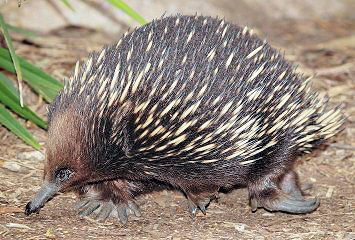Echidna Reproduction
| Adult echidna |
 |
Echidna have a 16-28 day gestation period. They usually only produce one egg a year. It is 1/2-2/3 inch (1.3-1.7 cm.) in length and has a leather hard shell. The mother puts the egg into her abdominal pouch, which only develops when she becomes pregnant and then regresses when her baby no longer needs it. To get the egg into the pouch, the mother curves her body tightly into a "C" shape, scoops up the egg with the tops of her hind feet, and pulls them up until the egg rolls into the pouch.
The echidna egg has relatively less yolk than the eggs of birds and reptiles. Yolks are the main nutrient sources for developing embryos. Echidna embryos don't need as much because they don't stay in the egg for long. They hatch out in around 10 days. The physically immature baby echidna breaks through the shell with a specialized reptile-like egg tooth. At birth, they are the size of a raisin and are known as "puggles". They are still hairless and blind at this stage.
After birth, the baby echidna nurses by sucking (or possibly only licking) on two thin areas of skin over the mammary glands within the pouch. There are no nipples. The platypus mammary glands also lack nipples.
When a baby echidna is around 1 pound in weight in 45-55 days, it begins to develop sharp spines on its back and sides. Subsequently, the mother puts it into a nursery burrow for 6-7 months. She returns to the burrow every 5-10 days to nurse her baby. At around 7 months, the young echidna is physically mature enough to go off on its own.
Copyright © 2011=2-12 by Dennis
O'Neil.
All rights reserved.
illustration
credits